
Meet the key players
ISSUE 188 | SPRING 2024 Surrey Wildlife Trust
Irruption eruption! A walk around Newdigate Brickworks
special:
PLUS:
Wilder Schools Space4Nature

2
Surrey Wildlife Trust’s membership magazine, published three times a year.
Surrey Wildlife Trust, School Lane, Pirbright, Woking, Surrey GU24 0JN.
T. 01483 795440 E. info@surreywt.org.uk
Editorial enquiries and contributions should be sent to the editor: Oliver Fry
T: 01483 795440
E: oliver.fry@surreywt.org.uk
© Surrey Wildlife Trust 2024
DESIGN
The Way Design
E: hello@thewaydesign.co.uk
W: thewaydesign.co.uk
WRITER
Simon Prichard
E: simon@zurito.co.uk
ADVERTISEMENT ENQUIRIES:
Charlie Thefaut
E: charles.thefaut@surreywt.org.uk
MEMBERSHIP
New memberships, gift memberships, change of address, change of bank details, cancellations and amendments should be sent to the Membership Department at the address above, or telephone the Membership helpline: T. 01483 795445
E: membership@surreywt.org.uk
CHARITY
Patron: Dame Judi Dench
Chair: Angela Swarbrick
Chief Executive: Sarah Jane Chimbwandira
Director of Finance: Sarah Glasspool
Director of HR, Culture & Support Services: Catherine Roberts
Director of People Engagement: Aimee Clarke
Director of Reserves Management: James Herd
Director of Research & Monitoring: Mike Waite
Director of Nature Based Solutions (NBS) and Partnerships: Zoe Channon
Surrey Wildlife Trust is a member of the Wildlife Trusts Partnership.
Registered Charity No 208123
Registered Company No 645176
VAT No 791 3799 78
Cover image: Blackcap © Jon Hawkins
All images © SWT unless stated
FIND OUT MORE ABOUT OUR WORK:
Like us on Facebook
Follow us on Twitter
Find us on Instagram surreywildlifetrust.org
Crunch time! Vote for nature in 2024

“The next government has work to do”
The UK’s next General Election seems to have been around the corner for months, but now there’s a sense that the parties are starting to line up their policies in earnest.
This got me thinking about the commitments they could make that would make the most difference to nature recovery. As you may know, the UK has a formal target of halting nature’s decline and protecting 30% of land and sea by 2030. The next government has work to do.
First, The Wildlife Trusts would like to see them implement a clear delivery plan to deliver this 30x30 target. To date only around 3% of land and a maximum of 8% at sea is protected – and there’s still no clear plan for the rest.
Second, we must look to nature to address the climate crisis. This means using affordable, natural carbon solutions within a cohesive set of government policies that deal with climate change and nature habitat restoration in tandem. This means expanding carbon-storing habitats such as woodland and rewetting lowland heaths, while reducing emissions and transferring to clean energy and transport. We need naturebased solutions to buffer us from the worst effects of climate chaos, restoring and re-wiggling rivers to reduce flooding and drought, expanding tree cover to cool our towns and cities, bringing back missing species such as Beavers that help slow down floodwater and reduce river pollution.
Third, the state of our rivers is a national disgrace. Creating natural habitat buffers for wildlife alongside rivers would help the natural world,
improve water quality and protect both farmland and housing from devastating floods.
Fourth, we need to build homes that renew people’s right to nature and promote health and wellbeing. Young people can’t find affordable housing and education doesn’t connect children to the natural world. The planning system must encourage housebuilding that protects vulnerable ecosystems and creates new communities with access to a vibrant, nature-rich environment.
Fifth, we need a sustainable future for British farming. The destruction of nature and the impacts of climate change are the biggest threats to food security in the UK. Food production relies on healthy soils, pollinators, and resilience to a changing climate. Farmers deserve well-funded, naturepositive farming schemes. Through fair rules to protect nature on all farms, we can drive innovation and secure the future of a resilient rural economy.
I look forward to reading those manifestos when they appear – and I urge you to do the same. I’m sure you will think carefully about the parties’ ambitions and plans for nature before you cast your vote.
As always, thank you for your support.
 Sarah Jane Chimbwandira Chief Executive
© Jon Hawkins
Sarah Jane Chimbwandira Chief Executive
© Jon Hawkins
3 SPRING WELCOME

WAXWING
This splendid image was taken by Jon Hawkins in a small residential close in Farnham. Jon says: “They were feeding on one solitary Kashmir Rowan Tree. Every morning at about 8:30am about 50 birds would perch high up in another tree about a hundred yards away and then they would occasionally all swoop down and spend
a few minutes stuffing themselves before flying back up in the other tree to digest their feast. They’d do this every 10-15mins over the course of an hour before disappearing until around 2pm, when they’d do it all again.” There may still be some Waxwings about, as they’ve been known to remain in the UK until April…
4 SPRING PHOTO OF THE SEASON
© Jon Hawkins




16 IRRUPTION ERUPTION! 14 WILDER SCHOOLS FEATURES 8 400 million years and counting Protecting remarkable plants 10 Celebrating Katy Fielding 18 Space4Nature Meet the key players 21 Bridging the divide Uniting the academic and the practical 22 My spring species 24 In defence of The modern Luddite 25 Remembering nature's defenders 29 Member focus REGULARS 3 Sarah Jane Chimbwandira 6 News 26 Corporate news 27 Introducing Simon Pritchard NATIONAL 30 UK news 32 Going against the flow 34 Migrating birds IN THIS ISSUE... A WALK AROUND NEWDIGATE BRICKWORKS 12 Want to have your image featured as our next ‘Photo of the season’? Share your best photos of Summer with us. Email them to: oliver.fry@surreywt.org.uk or share them on social media: @surreywt #surreynature GIVE US YOUR BEST SHOT Snipe © Fergus Gill 2020VISION Barnsbury Community Action Day Hawfinch © Andy Morffew 5 SPRING CONTENTS
OUR NEWS
Tomorrow’s conservationists join SWT
In 2023 the first cohort of Nature Restoration Trainees began their year-long paid traineeships with Surrey Wildlife Trust.
Since September Lucy Smith, Robert Maxted and Henry Ford have been working alongside our Reserves Officers in our East, West and Central teams.
The trio have gained experience in practical conservation, developing skills to prepare them for their future green careers.
From leading volunteer work parties and conserving habitats, to operating machinery and helping at Trust events – the trainees have had an action-packed start to their time at the Trust. Lucy has also recently taken on a General Officer role with the SWT Youth Action Committee and can’t wait to get started.
When asked what advice they’d give to someone trying to begin a green career, the response was unanimous: volunteer. Lucy Smith said “Don’t be afraid to get yourself out there! Experience will help you decide what you enjoy doing and what’s important to you.”
2023 CONSERVATION GRAZING APPEAL:
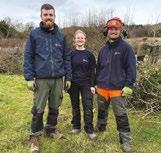
Find out more about our traineeships at surreywildlifetrust.org/getinvolved/volunteer/traineeships
A message from Director of Reserves Management James Herd
When we launched our fundraising appeal in November with the goal of raising £50,000 to support conservation grazing across the county, we’d never have believed that within one month, you’d have smashed that target. Having now received almost £60,000 from our members and supporters, I want to extend my very warmest thanks to everyone who donated.
Whether you are among the generous handful who gifted us a large sum, or simply chipped in a few pounds, we’re hugely grateful. Thanks to you, we can now not just keep our herd of Belted Galloway cattle and our flock of sheep fed, watered and attended to, but we can build on our plans to introduce Nofence grazing practices on more of our reserves. My team and I will keep you updated as these plans evolve, and we look forward to telling you more about how conservation grazing is helping create and enhance habitats that harbour the maximum possible biodiversity and bio-abundance. We know that not everyone has an abundance of spare cash at present, and Surrey Wildlife Trust prides itself on ensuring that the money we receive from members of the public is channelled not into bureaucracy, but into front-line conservation.

Be assured that this will apply here, and to all future fundraising work – and please do keep following us via this magazine and online to see how your generosity is directly benefiting the wildlife you care about.
I have one further request. In addition to our conservation grazing HQ at Bonhurst Farm near Guildford, we still require additional ‘layback’ space – secure winter quarters and grazing sites – for our cattle when they are ‘off duty’ over the winter months. If anyone reading this owns or manages a suitable facility – ideally stock fenced, with mains water and a minimum 15 hectares in size – please do contact me directly at james.herd@surreywt.org.uk. Not every reader of this magazine owns a farm, but it’s always worth asking…
SPRING NEWS
6
Lucy, Robert and Henry

Volunteers boost conservation at Cranleigh Waters
In 2018, Surrey Wildlife Trust began a project to restore Cranleigh Waters in partnership with the Environment Agency and Thames Water.
In September 2023, Cain Bio-Engineering reprofiled riverbanks along the old nursery stretch of Cranleigh Waters by reducing the width and enhancing gravels. The overly wide, deep, and silt-dense area was transformed into a stretch with clean gravel, wiggly low-flow channels and shallow banks. The changes allow the river to function in a more natural way, benefiting wildlife and acting as natural flood management. We hope to see an abundance of marginal vegetation sprouting along the improved stretch of river, as well as the return of Kingfishers and other wildlife. This spring and summer, volunteers will help remove Himalayan Balsam from the area to encourage native species.

In November 2023, we purchased water quality testing kits from local charity Water Rangers thanks to a grant from Councillor Liz Townsend. The kits were given to Cranleigh Civic Society who have been monitoring Cranleigh’s waters with us since 2018. The volunteers can now test for a range of factors including phosphate, nitrate and temperature, creating a holistic picture of river quality in Cranleigh. In partnership with Water Rangers, the data collected by the society will be used to monitor general river health and gain a greater understanding of the effects of pollution events in Cranleigh. We can’t thank Cranleigh Civic Society enough!
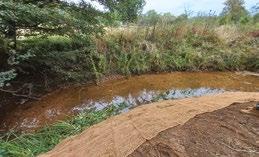
SPRING NEWS
Malcolm Brown
Kingfisher ©
Cranleigh Waters – before
Cranleigh Waters – after
7

400 MILLION YEARS AND COUNTING
SWT is working with the Species Recovery Trust to protect a remarkable plant.
8 SPRING SPECIES FOCUS
Despite the name, Marsh Clubmoss is a fern. It’s also a living fossil belonging to a strange relict family of plants that first appeared on earth 400 million years ago. These trailblazing plants were the first to capture carbon dioxide in industrial quantities, and probably the first to harness the power of fungi and establish symbiotic mycorrhizal relationships.
Decline and rise
Formerly widespread across the heathlands and wet mires of the UK, Marsh Clubmoss has dramatically declined along with these habitats in recent decades. Its last stronghold is in the New Forest, but we are working with the Species Recovery Trust (SRT) to boost its presence here in Surrey. The two organisations have previously collaborated on projects for the beautiful Deptford Pink wildflower, the Window-winged Caddisfly and the Heath Tiger Beetle.
Winning combination
SRT Conservation Officer Holly Stanworth explains: “We’ve been focusing on Marsh Clubmoss for fifteen years and we have a huge dataset from sites across England and Wales. We’ve recorded dramatic losses in the southeast, so we are working with several Wildlife Trusts and other partners to trial ways of remedying this. We’re focusing on creating microhabitats of bare exposed peat on selected sites.”
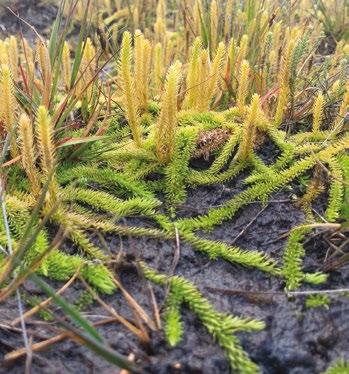
Cow power
Marsh Clubmoss favours compressed bare peat and the wet edges of sphagnum beds, often growing alongside sundew, bog asphodel and bog mosses. It is thought to have thrived in the presence of large herbivores that create disturbance then move off. This affinity with postdisturbance conditions makes it highly receptive to conservation grazing, as SWT Conservation Manager Adam Bolton explains:
“We graze our herd of Belted Galloways on heathland from spring to autumn to keep on top of coarse grasses and allow smaller, less prepossessing plants, such as Marsh Clubmoss, to compete and grow. Because the cattle rip out plants with their tongue, they also open small patches of bare ground, while their hooves poach wetter ground to create structured micro-habitat. Using Nofence technology we can be precise and nimble in targeting specific areas and even individual species. Meanwhile, our volunteers and contractors remove larger scrub that restricts light and therefore photosynthesis.”
Heavier-duty mechanical measures can be effective, but have limitations,” adds Holly: “Diggers can create bare ground and even replicate higher grazing pressure by compacting the soil and distributing spores, but if the scrapes are too deep, they may affect key factors such as fungi, hydrology, or nutrients.”
Translocation plans
As well as working with us on existing populations of Marsh Clubmoss, SRT has also started to trial plant translocation techniques, with a long-term aim of returning plants to other sites. “Our species expertise complements SWT’s extensive knowledge of local ecology and habitats, and pooling our resources gives us more impact,” says Holly.
Follow the progress of this project in future issues of Surrey Nature. ■
Marsh Clubmoss
9 SPRING SPECIES FOCUS
KATY FIELDING
UNCOMMON TOUCH
“I was always interested in nature and got my first bird book when I was seven. When I studied philosophy at university I specialised in animal and environmental ethics. I still think this rather unconventional background helps me understand people’s motivations and how they think about the environment. We all know what we need to do, but...
However, nothing beats getting out into the natural world, and learning from practical experience. Backpacking in Australia and southeast Asia showed me there were viable career paths in wildlife and conservation; it was inspiring to learn about others’ experiences on game reserves and in similar work across the globe. Throughout my undergraduate degree I volunteered in the Ecology Department weekly, before going on to complete a Wildlife Management and Conservation MSc. Upon leaving higher education I worked for the RSPB in the Peak District and then Brighton, before arriving at SWT in autumn 2016.
I started as maternity cover three days a week and worked in a farm shop the other two to get my foot in the door at the Trust – and after six months joined permanently as a full-time liaison officer in Reserves Management, covering sites such as Whitmoor Common, Wallis Wood and Vann Lake. Overseeing my patch involved many responsibilities, including working with contractors, landowners, volunteers and local communities to get the best results for nature. I also led guided walks and gained my chainsaw and brushcutter certificates.
By early 2020, the Trust was looking for a project manager for our Hedgerow Heritage project. It seemed really interesting and a great next step.

However, as soon as I started getting to grips with its theory and practice, the country went into lockdown and, like millions of other people, I found myself on furlough.
“By giving the land space to breathe, we are seeing species from Dingy Skipper and Green Hairstreak butterflies to Barn Owls and Skylarks flourishing here.”
Growing digital
When I returned in August, remote working was the norm, which might seem tricky when you’re trying to recruit volunteers to survey and lay hedges. I realised that we needed to think differently and capture a new spirit. I learned as much as I could about hedge planting and laying and, along with our events genius Sophie Coad and the education and communications teams, shifted our focus online. We organised surveys, apps, Facebook
Live sessions, webinars and even a creative storytelling competition – all celebrating these wonderful things called hedges and the huge range of wildlife they support. We were determined to capitalise on people’s renewed enthusiasm for nature, and I was bowled over by the level of participation from local people.
I think there’s much more acceptance that these vital arteries for biodiversity are critically important, and we’re still carrying that momentum forward now – not least with last year’s Hedgerow Festival at West Horsley Place, which was a wonderful opportunity to thank the volunteers, members and supporters who make our work possible.

10 SPRING CELEBRATING OUR PEOPLE
Skylark © Fergus Gill 2020VISION

A hedgerow hero
I’m still Project Manager for Hedgerow Heritage until it ends in its current form later this year, as well as SWT Conservation Manager for central Surrey, where I manage more than 20 reserves, mostly chalk grassland and woodland. This means contributing to management plans, planning conservation activity, and working with contractors, reserve officers and our volunteers team.
We’ve also established a new reserve at Pewley Meadows in Guildford over the last two years. This has kept me occupied with organising surveys, plans, fencing, infrastructure, and our partnership with an incredible local community group – and the rewards are already visible. By giving the land space to breathe, we are seeing species from Dingy Skipper and Green Hairstreak butterflies to Barn Owls and Skylarks flourishing here.
This year marks another change; I’m joining the Trust’s nature-based solutions (NBS) team, where I hope to
inspire and empower other landowners to do more for nature.
Outside work I’m pretty busy too. Having been part of the England women’s 27s team that won bronze in the 2019 Touch Rugby World Cup in Malaysia, I’m in training for the 2024 home World Cup in Nottingham. I’m hoping to be named in the final squad in a couple of months.
Touch is an amazing sport – played by both women and men, it’s non-stop, great for fitness, requires collaboration and a positive mentality and it really makes you think clearly. As it happens, these are skills I need for work too, so there’s a very positive feedback loop between my leisure time and my professional life. Again, I’ve learnt that the more active you are, the better you feel and the more you can get done.” ■
Katy Fielding: birdwatcher, philosopher, hedgelayer and international athlete. We hope this splendid mix of qualities will benefit Surrey’s nature for many years to come.

“Outside work I’m pretty busy too. Having been part of the England women’s 27s team that won bronze in the 2019 Touch Rugby World Cup in Malaysia, I’m in training for the 2024 home World Cup in Nottingham.”
Katy has helped promote the proper management of hedgerows © Jon Hawkins
11 SPRING CELEBRATING OUR PEOPLE
A reserve safari at
Newdigate Brickworks
‘Newdigate Brickworks is steeped in history and has a warm community feel’

Early this year Digital Marketing Executive Billie Pearce set off to explore this varied reserve alongside Conservation Manager Emily Jupe.
On a bitter winter’s day, the optimistic sun blanketed the site’s 24 hectares in a serene morning glow. Frosttipped tufts of grass, stripped-bare seedheads and glistening pools of ice painted a spectacular scene. This sleepy corner of Newdigate was silent but I could feel a hum of life, hinting at the abundant fauna nestled within.
On the site of a former claypit and brickworks, this hidden haven boasts woodland, grassland and scrub, as well as six water-bodies which attract Great Crested Newts, various Damselflies, Broad Bodied Chaser and Emperor Dragonflies, Kingfishers and even Snipe.
Opposite the purpose-built carpark lies an open grassland compartment where a flock of Fieldfare took flight. SWT’s Eastern reserves team has
ambitious plans for the site: Emily motioned towards a swathe of thick scrub before explaining, “We’re trying to restore the productivity of the grassland on site so – as with many of our eastern reserves – it’s crucial that we implement a grazing regime. We’d like to achieve a mosaic of age structures and really clear out the grassland.” While some scrub is beneficial, the scrub on site lacks the age diversity that species like Whitethroats and – the site’s rumoured inhabitants – Nightingales, love. In the absence of a grazing regime, vital scrub management tasks like tree popping and scything are undertaken by our dedicated volunteers and reserves officers. Volunteers really are a crucial component of our conservation efforts.


12
Snipe
© Fergus Gill 2020VISION
Billie Pearce
Emily Jupe
SPRING RESERVES TO VISIT
Emily and the team are taking action to bolster Newdigate’s biodiversity. Rumours of the Forester Moth and anecdotal accounts of Glowworm prove the site’s potential. Emily says “We’d like to get some moth surveys going so we can ensure our efforts are complimenting their needs”. Glowworm larvae are generally found around hedgerow bases, so Emily identified hedgerow planting and management as a priority, before adding “It would also be wonderful to expand the impact of the Hedgerow Heritage project!” Blackthorn management took precedence last year as the team conducted a survey for Brown Hairstreak eggs alongside the charity Butterfly Conservation. Brown Hairstreak butterflies prefer Blackthorn with a younger age structure, so the team coppiced the mature Blackthorn on site.
Local groups like Friends of Newdigate Brickworks and Reigate & Redhill YMCA Angling Club support the conservation and regeneration of the reserve. Emily is pleased that there’s a motivated community body here that plays an active role in the site and takes an interest in its management. Angling Club members prevent illegal fishing at Newdigate and protect the water bodies and fish population. Two Voluntary Wardens host walks and record the species spotted on site. Emily said,

This
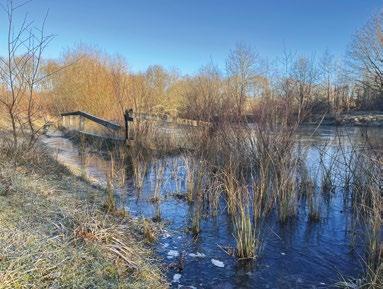
“Their presence is invaluable! Staff can’t be everywhere at once, and they help us understand what wildlife we have and how best to compliment it.”
The path rounded a corner, revealing an open expanse with a large lake at its centre. The low temperature didn’t deter the aquatic birds; Mute Swans and Mallard rattled their bills on the icy plane – likely in an attempt to hoover up food particles. Emily moved towards a sand bank at the lake’s edge before explaining, “This section is the designated dog swimming zone…we ask that dogs avoid other sections of the lake.” Despite the site’s dazzling winter beauty, Emily believes Newdigate is at its best in spring, which marks the emergence of the Bluebell, Dog’s Mercury, Wood Melick and an array of orchid species on site. Emily continued, “It has a real charm and is always very peaceful…I would encourage people to come for a walk around.” Site accessibility is great here,
with features including a car park and a range of walking routes. Whatever the weather, Newdigate really is a great spot for spending time outdoors. As the path circled back towards the carpark, Emily spoke optimistically about the future of the reserve. “This site’s a relatively open canvas for us and there’s such a nice variety of habitat, so lots of species have the opportunity to exist in harmony.” Despite our ongoing efforts to support nature’s recovery, it is still in decline locally, nationally, and globally. Never one to back down from a challenge, Emily concluded, “I think you always have to have hope. Small changes can have big impacts and whatever you do for nature will make a difference.”

If you’re interested in volunteering with us, contact volunteers@surreywt.org.uk or visit surreywildlifetrust.org/get-involved/volunteer more information.
Great Crested Newts make their way to the water in March.
© John Bridges
Right: Trees extend to the water's edge.
13 SPRING RESERVES TO VISIT
bankside habitat will be full of life in spring
The classroom on earth
SWT is on a mission to introduce children to Surrey’s amazing wildlife and habitats, and we have run education sessions on our nature reserves for over 50 years.
We often meet adults who remember visiting our education centre at Nower Wood, near Dorking, as a child. For them regular contact with nature has grown into a lifelong connection that is vital to their health and wellbeing. Sadly, many children today have no access to natural spaces.
Since late 2020 our education team has been testing new ways of working with children to improve their quality of life and learning, and help meet two of our key targets: to inspire one in four people to take action for nature and to restore 30% of land and sea for nature by 2030. Our Wilder Schools programme does this by enhancing biodiversity in school grounds, encouraging teachers to take more learning outside, and encouraging children and their families to actively participate in conservation work at school, at home and in the community. More than 30 schools are now taking part and we have reached more than 6,500 students from secondary, primary, and special schools.
“Wilder Schools is an inspired scheme to help schools plan for a greener future. It helps students to prioritise the environment whilst making a difference to their school community and having lots of fun in the process.”
Wright, Reigate Grammar
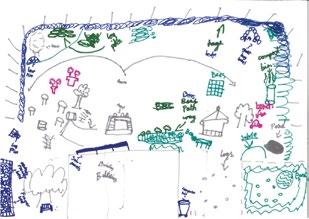
Conservation begins at school
Our team starts by going into a school, talking to students and exploring the grounds with them. We ask them to create a vision for nature on their site and take their ideas to the senior leadership team. As the project develops they share their ideas with the wider school community through posters and an assembly. They run a fundraising event for materials, such as pond liners and wildflower seed.

Then comes the physical work, which means some get to use tools for the first time. The programme has already supported more than 100 habitat improvement projects, including creating meadows, planting hedgerows, installing and managing ponds, and improving woodland, which is great for nature and also makes a wonderful outdoor learning space.
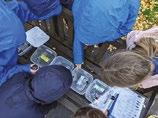 Jo
Students at Powell Corderoy School, Dorking using aerial photography and survey skills to map habitats and create their visions for nature.
Jo
Students at Powell Corderoy School, Dorking using aerial photography and survey skills to map habitats and create their visions for nature.
SPRING WILDER SCHOOLS
An example vision from a student at Powell Corderoy School, Dorking.
14
greatest
“It was great the way each activity could be adapted for the different ages and linked to a range of national curriculum subjects.”
Staff at Powell Corderoy after an INSET day
Broader picture
We also include the wider community: getting parents involved keeps the project moving, enables them to learn new skills and shows them how much their children enjoy looking after nature.
Through school newsletters and websites we offer seasonal advice on how to help wildlife at home. Last year hundreds of families from our project schools took part in the Big Garden Birdwatch and No Mow May and recorded over 500 actions for nature. These included adding bucket ponds, bird feeders and nest boxes to gardens, putting a hole in a fence for hedgehogs, and creating a log pile. Other families took part in local litter picks and campaigns.
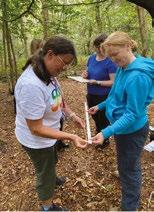
Time to celebrate
Last summer we hosted a celebration event at Nower Wood where students and teachers talked about what they had accomplished and the barriers they had overcome. Sharing experiences is a powerful way to recognise that small actions, when combined, can make a big difference. ■
Outdoor inspiration
We also try to help teachers in our project schools involve other year groups in outdoor learning. The goal is to connect the whole school with nature, now and into the future. INSET training courses have generated a wealth of simple, practical ideas for outdoor sessions in a broad range of subjects. At staff meetings we have evangelised the many benefits of being outside for students and teachers.
“Ross is doing a great job of inspiring the children and it's fair to say they are loving the sessions.”
Rebecca White, Barnsbury Forest School Leader
All kinds of support
Since the project began, we have worked with and trained over 450 teachers, including delivering formal, accredited courses such as ‘Leader of outdoor learning’ and ‘Forest School leader and assistant’. We invite them all to sign up to our free Nature Network and receive details of useful resources, free webinars and face-to-face training. Recently we ran a hugely successful Numbers in Nature course at Nower Wood to show teachers how to easily adapt an indoor maths session into an inspiring outdoor experience.
Teachers applying maths in an outdoor setting, September 2023.

Barnsbury Community Action Day.
Meadow Creation at George Abbot School, March 23 and June 23.
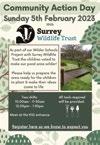
Before

After

To find out more about Wilder Schools, visit surreywildlifetrust.org/wilderschools
If you’re interested in becoming a Wilder School for the 2024/2025 academic year, please contact us at education.centres@surreywt.org.uk
Don’t wait – the deadline to apply is 28th March 2024.
15 SPRING WILDER SCHOOLS
Waite’s Wonders…
a


Director of Research and Monitoring Mike Waite explains why the UK is the destination of choice for some exciting avian migrants
As I write we are experiencing a ‘Waxwing Winter’; an event to be witnessed first-hand if you are able, as seeing just one Waxwing let alone a hundred-strong flock is one of bird-watching’s most memorable experiences. It is a truly stunning bird, and a member of a very small but distinctive family of most likely relict species scattered across the globe. Well-endowed with adornments, the
Bohemian Waxwing, to afford it its full moniker, is well-named and breeds closest to the UK in Scandinavia. It has a circum-polar distribution where it lives in the extensive northern conifer forests, though not wholly dependently on such trees. So why is their appearance such an irregular and unpredictable event, and why do they even bother to visit us?
Irruptions:
bird-watcher’s bonanza © Jon hawkins
16 SPRING WAITE'S WONDERS
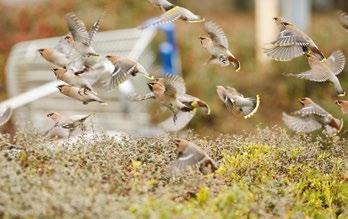
Waxwings arrive on what is known as an ‘irruptive’ wave, i.e. in an Irruption year effecting the species, that culminates from several coinciding factors. Typically, a multi-year period of relative glut steadily builds populations until the inevitable happens; a failure in their main staple sustenance, in the Waxwing’s case Rowan and other berries, forces them to look elsewhere – spectacularly en masse. This can also be amplified by a particularly cold snap in this profoundly Arctic-influenced zone. It should not be confused with normal wintering migration, that routinely brings thousands of birds of many species to the UK, driven simply by their ability to escape to a much milder climate. Redwings, Fieldfares and Bramblings are the most entirely novel of these, but the numbers of common residents such as Chaffinches,

Goldcrests, various buntings and even Robins are all swelled in wintertime by arrivals from the Continent. For some reason this year, this has unusually included Coal Tits. Other species notorious for irruptive behaviour include the Crossbills. Again, these come from the northern Boreal forests and in their case, are actually dependent on the seedcrop from these trees, which varies more regularly in its productivity (but still not annually). ‘Crossbill winters’, at least affecting the Common Crossbill, are subsequently a more regular event, also involving internal movements of birds from within the UK – from Scotland and the north-west generally. 2013-14 was a highly memorable Crossbill irruption winter, when significant numbers of in-comers also brought with them small groups of the two other Eurasian crossbill species; Twobarred and Parrot Crossbills. For my sins, I only ‘twitch’ birds when the species in question is very high on my list of ‘must-sees’, but a male Twobarred Crossbill certainly met such criteria, so off I went to Norfolk to see the small flock on offer at Lynford Arboretum. Ironically, later that winter we had at least one in Surrey at Farnham Woods.
The Hawfinch is an enigmatic bird that frustratingly eludes many bird-watchers. Late winter is a good time to up-your-game, as it is easiest (relatively!) to see at that time owing to a regular migratory influx of Hawfinches into the UK.

But this is very variable in terms of numbers– such movements are far more apparent on the Continent itself. The Hawfinch is also subject to a much rarer irruptive behaviour, however. In 2017-18 the UK was on the receiving end of thousands of Hawfinches, in unprecedented numbers, that can only have been driven by some parallel failure (in combination with normal winter movements) in the availability of food. As the Hawfinch eats a range of ‘stoned’ berries, as well as its favoured Hornbeam ‘keys’ (in Britain at least), this must have been fairly catastrophic. At well over 100 birds, one of the largest flocks of Hawfinches ever recorded was present in and around Box Hill’s Juniper Top for several weeks – a spectacularly memorable experience for those who made the special trip to view it… as indeed did your intrepid correspondent. ■
 © Andy Morffew
Suburban Bohemians: supermarket car parks are an important source of berries © Terry Whittaker / 2020VISION
Redwings love Holly berries
© Jon Hawkins
Waxwing
© Jon Hawkins
The unmistakeable but elusive Hawfinch
© Andy Morffew
Suburban Bohemians: supermarket car parks are an important source of berries © Terry Whittaker / 2020VISION
Redwings love Holly berries
© Jon Hawkins
Waxwing
© Jon Hawkins
The unmistakeable but elusive Hawfinch
17 SPRING WAITE'S WONDERS
SATELITTES, AI… AND HAND LENSES
As the pioneering Space4Nature project reaches its halfway point, we check in with some of its key contributors.
Funded by a £1.2 million grant made possible by players of People’s Postcode Lottery, Space4Nature is a partnership between Surrey Wildlife Trust, the University of Surrey, Buglife and the Painshill Park Trust, which aims to map Surrey’s habitats more accurately than ever before. Using the latest satellite earth observation imagery and artificial intelligence alongside citizen scientists on the ground, it will enable the Trust to work with landowners across the county to create, restore and connect fragmented habitat and support healthier biodiversity.
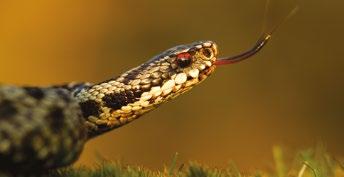

This is a multifaceted project with many moving parts and I’m extremely pleased with progress to date. The University of Surrey is focusing on mapping, observation data, and machine learning. Buglife’s B-Lines has already reached its overall project target for habitat restoration.

And here at SWT our citizen science programme has been fantastic. We’ve trained dozens of volunteers on survey methodology and our S4N app, and we’ve completed many surveys.
We’ve been adapting as we go. Our original bid presented an eyecatching idea, but we had many details to iron out. Some of my major responsibilities have been to agree the overall project plan and define the right outcomes and KPIs (key performance indicators that measure progress over time for a specific objective).
Taking a partnership approach naturally means we have all learned to accommodate others’ ways of working, from academic to entrepreneurial. Different organisations have different styles, timelines, and stakeholders.
I’m also struck by the level of external interest, including
from other partnerships and public bodies. We talk regularly to other Wildlife Trusts, NGOs, National Parks and so on. The word is spreading.
The project’s wider effects are also potentially significant. It has boosted our own research and monitoring team and promoted the use of technology. However, while many people are using satellite technology in conservation, for me citizen science is the key difference that can deliver accurate mapping and aid landscape recovery and connectivity.
Meanwhile, we are also working with The Land App, which provides easy-to-use technology for landowners and managers to map their land. It’s a gateway to a huge constituency of users, from farmers to water companies, who already use it to plan interventions and access funding.
Andrew Jamieson SWT S4N Project Manager
Adders are a flagship species
18 SPRING SPACE4NATURE
© Danny Green 2020VISION

Sometimes I meet people who are deterred from volunteering with SWT because they think it may be too physically challenging. This project is a great example of how we welcome everyone, whatever their age, physical strength, or mobility – we currently have more than 100 taking part – and every single hour helps.
Training is free and after three hours they’re citizen scientists, ready to go out and survey some of the most beautiful places in Surrey, such as Chobham Common, Quarry Hangers and Puttenham Common. This year we aim to expand into other areas, including urban environments. Each volunteer is assigned a designated area. Within a one-metre quadrat they use a simple smartphone app to identify plants, record the amount of bare ground, sward height, other interesting species, signs of

My role is primarily technical: to combine the power of artificial intelligence and machine learning with satellite imagery, so we can rapidly identify and match habitats on a large scale. However, to make this work, the ‘ground truth’ that comes from citizen science is priceless.
Essentially, the AI learns to recognise different habitats by understanding patterns of spectral reflectance in the satellite imagery, which we match to observations on the ground. Together this data helps us efficiently create accurate habitat maps. To date we’ve made promising progress on chalk grassland and heathland distribution

Adonis Blues will benefit from greater connectivity
© Tom Hibbert
and Research
at the Centre for Environment and Sustainability, University of Surrey.
– and we’re continually refining the models to make them more accurate.
So far we have been making predictions about habitat quantity; next we will look at its quality, which requires a new methodology. We need to collect data from more sites to better understand the variables. Combined with quantitative data, this will feed into our recognition and capture of biodiversity net gain (BNG), which property developers are now obliged to deliver as a condition of planning permission.
Already we know this is the most accurate mapping method we’ve ever had – and one that DEFRA and ecologists can rely on.
grazing and so on. Cheat sheets and QR codes make the whole process really easy. For accuracy we need the plants to be in flower, so most of the work is done in spring and summer. Some people do it in pairs or groups, while others prefer to go solo. We have teenagers, pensioners and everyone in between.
Our volunteers are so positive and enthusiastic, it’s wonderful. Forty-two of them came to our open forum event last summer to hear the S4N partners explain their roles. The University of Surrey presentation on satellites and data feeds was particularly popular. It’s also fantastic to see them developing their skills and becoming recorders of more detailed wildlife information. We’re delighted to get closer to our target of one in four people taking action for nature.

About the satellites
Space4Nature uses images from the PlanetScope mission launched by Planet Labs, part of the European Space Agency. The mission comprises more than 430 different satellites, which circle the Earth every 90 minutes at relatively low orbit (c.500km). The satellites each weigh less than 6kg and measure 10x10x30cm. Together they can image almost all the land on Earth every day. They use spectral reflectance to remotely identify and measure different types of vegetation. Planet Labs provides this data free of charge to the S4N project, as it is for academic and research purposes.
For more information visit earth.esa.int/eogateway/ missions/planetscope
Dan Banks
SWT Citizen Science Officer
Ana Andries
Lecturer
Fellow
19 SPRING SPACE4NATURE
Dr Andries assessing satellite imagery
Tawny Owl and Dormouse numbers will rise as woodland is restored © Dale Sutton / 2020VISION

Mike Waite
SWT’s Director of Research and Monitoring

Having been involved in selecting our test sites, I’m glad that we haven’t had many unexpected results so far – although the Earth Search bioblitz at Painshill Park last summer was even better than we hoped, with some 300 species identified. In general, we chose heathland and chalk grassland sites that proved to be representative of their respective habitats.
The ultimate prize is an accurate understanding of habitat quantity and distribution right across Surrey. Our current picture is flawed and S4N offers a new way to remotely interpret data and provide information that is essential for connectivity modelling.

At this early stage we’re still seeing some anomalies, when the technology misrecognises a particular type of grassland, but this only helps us refine it. There are many factors to consider, such as weather conditions and time of year. In some cases, we are trying to find the sweet spot – the narrow window when a specific habitat is most easily identified.
Land managed by SWT, National Trust and other conservation organisations is already well documented, which is why we use it as test sites. The critical shift is to extrapolate onto private estates, where there are huge opportunities to improve things for wildlife.
These landowners tend to be receptive to the idea of acting for nature, as long as you can show them the data. With environmental policy and subsidies still in flux after Brexit, this is the ideal time to advocate with them.
As for improving the prospects of particular species, I could name three flagships that will certainly benefit from our work: Dormouse for woodland; Adonis Blue butterfly for chalk grassland; and Adder for heathland and acid grassland. All three tend to be on fragmented sites, with a limited dispersal range, so better connectivity will be vital for their prospects.

Space4Nature Conservation Officer, Buglife
Buglife’s practical conservation work in the UK includes B-Lines, a beautiful solution to the problem of the loss of flowers and pollinators through habitat fragmentation. It involves restoring and creating 3kmwide lines of wildflower-rich habitat through countryside and towns to provide connectivity for invertebrates and other wildlife.
Being part of S4N has enabled us to deliver this for the first time in Surrey – and the results are spectacular. Halfway through the project, we have already beaten our target of 30ha of new, restored, or enhanced B-Line habitat. From now on, we aim to keep up the momentum, reach out to more landowners, and refine our site selection. The machine-learning feedback loop inherent in S4N helps us monitor the impact of our efforts.
As the project continues, we’re learning how to address a range of different sites, from nature reserves to community green spaces, and to work with private landowners, such as Painshill Park Trust, conservation NGOs, and local authorities. For example, we’ve recently overseen reseeding at Tyting Farm near Guildford and scrub clearance at Quarry Hangers.
Above all, working with our S4N partners is a wonderful opportunity to learn. We don’t always agree on everything, but we have the same overarching goal: to improve Surrey’s habitats for nature. ■
Louis Harrington-Edmans
20 SPRING SPACE4NATURE

BRIDGING THE DIVIDE
A research project is uniting the academic and the practical
Ben Siggery is GIS, Research and Monitoring Manager at SWT. He is also studying for a Practitioner Doctorate in Sustainability in the Centre for Environment and Sustainability at the University of Surrey, funded by the Space4Nature (S4N) project. Here he explains how the academic and professional aspects of his work fit together.
I’m now one year into my PhD, which aims to support S4N by providing a historic baseline against which we can assess the current state of the environment. In other words, I’m trying to determine how rich in life Surrey should be if it weren’t for the damage inflicted by human activity. This lies within a field of science known as palaeoecology, or the study of past ecosystems and environments.
As a Doctoral Practitioner, I want my research to benefit practising conservationists. This is because, while paleoecology has an impressive history, it can feel inaccessible. In my PhD I am exploring the barriers to integration in conservation, experimenting with ways to overcome them and providing guidelines for academics, so they can make their work more easily translatable into effective action on the ground.
OPENING THE DOOR
The first thing I learnt was that a PhD requires a vast amount of reading! Before I could start my own practical research, I needed to know what had been done already, where the gaps are, and what’s achievable. I concluded that palaeoecology has a huge potential to support conservation but that there’s a clear disconnect between academics and professionals, and valuable information is often hidden in specialist journals. What’s more, research projects are regularly designed without the input of practising conservationists.
Compare this with medicine, which has well established and funded procedures for researchers to circulate information to practitioners. Through S4N we are attempting to emulate this culture of knowledge exchange. I’m submitting my research outputs to both academic and practitioner
publications and looking at how we can reframe information that has already been published, but not widely read.
PRIMARY RESEARCH
In the second six months of my PhD, I published a study based on the responses of 153 conservation practitioners, and their familiarity with and attitudes to paleoecology. It revealed problems such as a lack of money and resources to carry out research, and poor communication with academia. However, I also identified potential solutions, including creating a centralised online database, more access to applied case studies, and better links to legislation and policy decisions.
The other recommendations to come out of the work are that academics should aim to use examples that are relevant to practitioners, co-author with experts from NGOs, provide open access to published findings, and write summaries in simple English.
PALAEOECOLOGY IN ACTION
After a lot of time in the library and at the computer, my first outing in the field was to Chobham Common. Researchers from University College London and I collected two sediment cores from ponds that have existed on the Common for hundreds of years. We pushed a long tube as deep as possible into the sediment at the bottom of the pond and extracted a sample. We then cut and bagged 1cm slices for laboratory analysis of four indicators of environmental change:
1 Diatoms, a type of microscopic algae that only survive in very narrow ecological niches. Through them we can examine a range of variables, such as pH, water temperature, and salinity.

2 Spheroidal carbonaceous particles (SCPs) are only produced by burning fossil fuels. Their first (oldest) occurrence in a sediment core will coincide with the industrial revolution. Increase over time can also indicate the impact of periods such as the 1950s, where there was a dramatic increase in the use of fossil fuels.
3 Macrofossils, which are usually the remains of plants and invertebrates, can tell us about the local ecology and species assemblages of the area over time.
4 Macro-charcoal remains tell us about the frequency and intensity of wildfires over the history of the site.
WORK TO DO
This summer the preliminary test results should begin to reveal some of the history of Chobham Common. In due course we will see what impact our findings may have on assumptions such as SSSI designations, and whether they inform our future heathland management strategies.
Meanwhile, I will be focusing on developing another case study with our Natural Flood Management Project at Wishmoor Stream. I’ll also be experimenting with ways to improve the accessibility of palaeoecology for conservation practitioners, through approaches like “recycling” existing data and looking into whether costeffective, lower resource studies can still provide the necessary level of information for conservation work. It looks like another busy year! ■
21 SPRING SPACE4NATURE
Ben at work on Chobham Common
My spring species
of spring on your doorstep Stars

It’s not just the rare stuff that counts, says Ecology Planning Advice Services Manager Rob Hutchinson. Here Rob sings the praises of three species which enliven springtime and aren’t hard to find or hear.
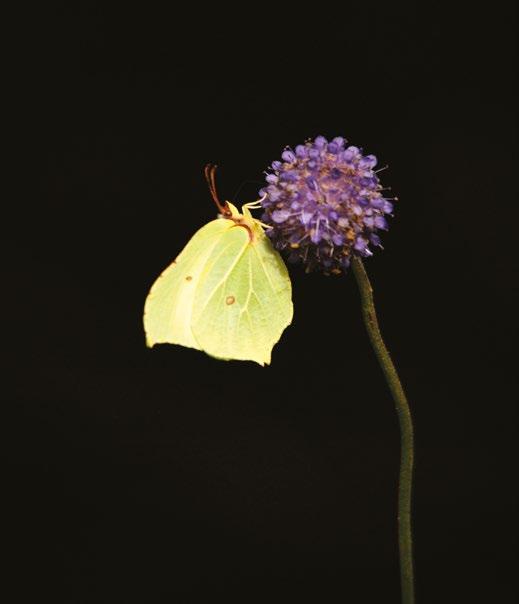
© Amy Lewis SPRING SPECIES FOCUS 22
Brimstone

Spring is a wonderful season for those of us who work in conservation: as the days lengthen and the ground warms up, a profusion of life springs forth, and one is reminded yet again of the richness and potential of the habitats that we care for. At this time, even species we don’t usually discuss all that much can seem quite magical: as winter retreats, a sudden burst of birdsong; an unexpected glimpse of a basking reptile; the flash of a butterfly’s wings. All can feel exciting and new.
And of course, these experiences serve as a reminder that the Trust’s mission isn’t just about saving the rarer species. It’s equally vital to maintain rich, accessible, biodiverse and bio-abundant environments that bring pleasure to all who visit them.
In that spirit, I’m spotlighting three common but characterful species that any amateur naturalist has a strong chance of spotting on many SWT reserves, or even in a suitably maintained wildlife garden, this spring.
Brimstone Butterfly (Gonepteryx rhamni)
This lovely large greenish-yellow butterfly with leaf-shaped wings is one of the first indicators of spring, as adults which have hibernated in woodlands emerge to catch the first decent rays of sunshine and to feed on
the nectar provided by flowers such as Bluebells, Dandelions, Primrose, and Celandine Look for single specimens flitting through woodlands or along hedgerows, or pairs spiralling skyward before descending to mate. The small green caterpillars, which can be found from late May, feed on Alder and Common Buckthorns and, like the adults, are well camouflaged among the leaves. An unusually long proboscis enables the adults to extract nectar from flowers such as teasel which are beyond the reach of many other butterflies.
Common Lizard (Zootoca vivipara)
Common Lizards can be found in a wide range of habitats such as woodland, grassland, heathland, wetland and hedgerow. Not to be confused with the longer, stockier and brighter Sand Lizard, this 10-15cm relative is typically brown accompanied with darker spots and stripes (although some specimens tend towards black or even green) and is widely distributed. Males have bright yellow or orangespeckled bellies whereas females have paler, plain undersides. From March, look out for them in sunny spots along woodland edges, gardens, stone walls and areas of fencing where they like to bask. Also known as the 'Viviparous Lizard', this species incubates its eggs internally, producing
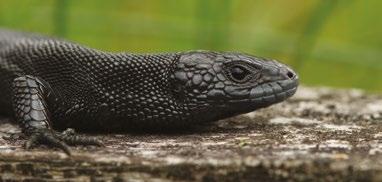

up to eleven live-born young in July. As with many reptile species across the world, common lizards are ectothermic which means that they cannot regulate their own internal temperature. I’ve typically seen them in decent numbers on reserves such as Chobham Common, Rodborough Common and Poors Allotment. On warm and bright days, scan the edge of lowlying vegetation and you may well witness one of our most charismatic reptile species basking or hunting.
Blackcap (Sylvia atricapilla)
This warbler’s fluting song, which to me can sound somewhat like the mechanical Star Wars character R2D2, is another welcome indicator of a change in the season. Although most are still summer visiting birds from Germany and north-east Europe, the Blackcap is increasingly spending the winter in the UK as our weather grows milder. It has a reputation for hiding in thick woodland vegetation, where its song is almost identical to that of Garden Warbler, however Blackcap has a hard “tack” call which can provide a distinguishing feature. Bramble and other dense woodland vegetation provide favoured nesting locations, where males have been known to build more than one cupshaped nest from which the female will chose.
These sexually dimorphic, Robin-size birds are avid eaters of Mistletoe berries, and the consequent rapid spread of seeds has helped this parasitic plant proliferate across the UK. Over a million pairs of Blackcaps breed in the UK and individuals and pairs are best spotted in woodland, tall scrub and gardens. ■
Melanistic Common Lizard
© Vaughn Matthews
Common Lizard © Jon Hawkins
23 SPRING SPECIES FOCUS
Female Blackcap © Steve Waterhouse
Personal view
SWT staff and stakeholders offer a personal insight into a wildlife-related topic.
In defence of The Modern Luddite
There’s nothing backwards about living closer to nature, and the Trust is helping people gain vital outdoor skills says Adult Learning Officer Sue O’Regan….
I recently had my friend’s niece Chloe stay with us for a few nights whilst she travelled Europe, and having heard about how she grew up, I was looking forward to meeting her. Her father, Martin, was top of his class at a prestigious American University, but after graduation decided to live ‘off-grid’ in the Appalachian Mountains. For 15 years, he and his wife built a life without mains water and electricity, all while raising their daughter.
Chloe was far from the naïve, sheltered young woman I had expected. She was well educated and charming, though unfamiliar with some of the latest fashion trends and certain social media influencers. This got me thinking about how I rely on so many modern conveniences to keep me going day-to-day, and whether I could ever live without what I consider to be ‘the basics’. This is not just a 21st century concern. During the Industrial Revolution in the 1800s, textile workers took action against the new machines they believed were robbing them of their livelihoods. They became a group known as the ‘Luddites’, who promoted the preservation of traditional skills and techniques.
Refer to someone as a Luddite today, and you’re likely accusing them of an inability to send an emoji or operate the latest gadget. However, there is a growing group who practice the Luddite ideology while also embracing modern technology. These people are not taking the dramatic steps that Chloe’s family did, but they still hold a desire to learn traditional skills from our past. Their reasoning for this can vary greatly, from wanting to save money, reduce their own environmental impact, or from intellectual curiosity.
Over the past few years, we have witnessed a dramatic upsurge in those wishing to learn how to scythe. While it can be argued that a shirtless Poldark slicing his way through Cornish meadows drove this, scything tutor and Best Quality champion Mary Ellis disagrees. ‘People are increasingly appreciating the diverse and practical ways in which using a scythe is much more efficient, cost effective and pleasurable than the mechanised alternatives.’ She goes on to point out that her students are not simply scything to make hay – they are mowing their back gardens, wildflower meadows, school grounds and road verges.

Sharpening and maintaining our own tools used to be the norm, but now there are people who do that for you. Even more worryingly, if a tool is no longer working effectively, many people will simply buy another. This is not only wasteful and costly, but also unnecessary, as Surrey Wildlife Trust helpfully offers a Tool Sharpening and Maintenance Course to train budding Luddites. Ownership of woodland has long offered economic value in the form of sustainable firewood and timber. Today, many desire to own their own woodland not simply for capital gain, but also for the environmental, ecological, and physical benefits it can provide. By understanding how our forebears effectively managed their woodland, we can blend this with modern working methods. Self-declared Country Boy Ross Packman runs our Small Woodland Management Course, which looks at both traditional techniques and up-to-date methodologies.
Labels can be offensive, insensitive and sometimes just misunderstood. It can be hurtful if you suggest that someone is ‘weird’ for never watching TV, or ‘irrelevant’ if they choose to write a letter rather than send a text.
By suggesting someone is a ‘Luddite’, it can infer they are somehow backwards, but this could not be further from the truth. The modern Luddite is simply curious to learn. Walt Whitman said it best – ‘Be curious, not judgemental’. ■
Marina Bakhmutchenco @Pexels.com 24 SPRING PERSONAL VIEW
The Luddite's happy place
©
Remembering nature’s defenders
Alan Holloway (1950-2024)
SWT outdoor learning manager Louise Shorthose pays tribute to a much-loved friend of SWT and the natural world.

Jean Combes (1927-2023)
We are grateful to Janice Fisher, Ann Sankey and Jean’s family for inspiring this tribute to a talented woman, scientist and artist.

We were so sad to hear that our dear friend, former colleague and longstanding volunteer Alan Holloway had passed away. Alan first came to the Trust in 1995 on a weekly placement from Brinsbury College, following a career change into conservation. After a spell with the National Trust, he returned to SWT in 2002 as a full-time member of the education team at Nower Wood and Bay Pond. He had a natural ability to engage children and adults of all ages and could make the most common plant or minibeast utterly fascinating.
Alan was intrigued by the living world and took it upon himself to research, observe and share his findings. He loved showing anyone new to the Trust, whether a visitor, volunteer or member of staff, the joys of engaging with nature. Following him around the wood you would see him hold out his hand to lure a hoverfly, wake
Jean’s childhood interest in wildlife resurfaced in the 1970s, when she gained a Certificate in Field Biology and taught adult education classes. She assessed 97 sites in Mole Valley for their wildlife value, forming the basis of the SNCIs organised by SWT. As a founder member of the new LA21 Nature Conservation Group in Mole Valley, in 1999 Jean helped survey the proposed course of a new pipeline. On discovering a colony of Wild Daffodil in one ghyll, the group got permission to transplant the bulbs to a less vulnerable location. Jean described this as one of the highlights of her botanical life.
More than 5,920 records between 1966 and 2012 have Jean’s name attached to them. She was a BSBI member and regularly exhibited her beautiful pencil drawings of grasses and trees at BSBI and RHS events.
up a tightly curled millipede with a gentle puff of breath or carefully drip water onto a puffball to see it explode with spores. Before you knew it, you would be dancing along to his X-O-Skeleton moves! He was always happy to deliver courses too, specialising in beetles and moths. Alan would regularly arrive at the crack of dawn to see what amazing species his moth traps or Longworth traps had caught overnight. Even when he retired in 2016, he continued to lead school groups as a volunteer and help us train new volunteers. Only last December, our new volunteers came back buzzing after a walk around the woods with him. We will miss Alan so much but feel privileged to have spent time with him and will share his knowledge with children and visitors for years to come.
Jean was also a knowledgeable ornithologist and undertook the Common Bird Census on Ashtead Common for the British Trust for Ornithology for 26 years. However, her most profound contribution to natural history is her unique set of records of the dates of spring bud-burst in four species of tree in Ashtead.
Jean started recording these when she was eleven and continued for more than 60 years, regularly sending them to Dr Tim Sparks at the Institute for Terrestrial Ecology. Her records show that leafing advanced by about five to seven days over the period. As a result, Jean was awarded the OBE in 2008 for services to phenology. Locally she was honoured by having The Combes Oak planted next to her home at Ashtead cricket ground.
Jean was a pioneer of citizen science and her influence is still felt today. We mourn her passing and send our condolences to her family and friends.
25 SPRING IN MEMORIAM


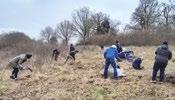
A Wild Work Day with Eiger Trading Advisors Ltd
Earlier this year, an enthusiastic team from Eiger Trading Advisors Ltd based in Leatherhead, volunteered their time to help protect and preserve our nature reserve at Norbury Park.
With guidance from Surrey Wildlife Trust Reserve Officers, and fuelled on tea and biscuits, the team from Eiger spent the day in the outdoors clearing scrub and using tree poppers to remove non-native species from the reserve. The team worked together, and at their own pace, to restore the habitat.
Norbury Park is a varied landscape, consisting of woodland and chalk grassland, making it home to an abundance of wildlife, from rare Bee and Fly orchids to Dormice and Roe deer. Therefore, its paramount that the habitat is well cared for and preserved so that the wildlife can continue to thrive there.
By having the support of local businesses such as Eiger, we can continue to support habitats like that at Norbury Park long into the future.
Not only do our Wild Work Days serve to support Surrey’s nature, but they also offer local businesses an opportunity for teams to get outdoors and enjoy nature. This helps to support the mental and physical wellbeing of their staff, and develops their team building skills.
"It was a very enjoyable day out in the Surrey Hills making a real difference to the local environment and learning about chalk grassland. A great team building experience!”.
Lauraine, Eiger employee
“It was an excellent and rewarding day, and we’re all looking forward to the next Wild Work Day”.
Stephen, Eiger employee
Thank you to the following businesses that have recently renewed their membership with us and continue to support our work: Affinity Water Chessington SES Water Sibelco Toyota (GB) PLC Wild by Designs Woking Golf Club Thank you to all of our business supporters Gold members Andreas STIHL Ltd Chessington World of Adventures Resort Eiger Trading Advisors Ltd KIA UK Ltd Oander Premier Miton Investors Toyota (GB) PLC Vestel UK West Hill Golf Club Wild By Design Landscapes Woking Golf club Ltd Silver members Affinity Water Ltd Jenoptik UK SES Water UK Power Networks (UKPN) Bronze members Sibelco Small Business members Forays Homes Landscaping Solutions Ltd Wienerberger Business supporters and donors Albury Vineyard Benevity British Wildlife Centre BUPA Car Take Back Co-op Cotswold Outdoor Clothing GiveaCar Haleon Dental Novuna Network Rail Project Five Ringway Surrey Choices Surrey County Council Surrey Green Burials Surrey Hills Photography Thames Water Utilities Ltd University of Surrey Vine House Farm Wild! About Coffee Interested in working with us to help the local environment, wildlife and people? Visit our website to learn about our corporate membership packages and other ways that your business can support our work: surreywildlifetrust.org/supportus/business-support. Contact us: E: fundraising@surreywt.org.uk Tel: 01483 795440 About our partnership with Eiger: Eiger Trading Advisors Ltd is an award-winning company, offering financial technology solutions to the Islamic financial market. In Spring 2023, they became a Gold Corporate Member of the Trust, supporting our vital work across Surrey. 26 AUTUMN CORPORATE NEWS

The man behind the words: Simon Prichard
Our staff writer explains himself….
“I’d been an SWT member for several years when I started working as a freelancer for them in 2015. I focus mainly on Surrey Nature, but over the years I’ve contributed to everything from annual reports to interpretation boards. I’m a jack-of-all-trades, with clients in many industries and no scientific training since O-level, but that’s fine. Many of our readers are in a similar situation – and I have plenty of experts on tap.
It started as just another business relationship, but I soon realised there was something unusual going on. I work with all sorts of specialists every day, but the people here at SWT are on a different level. Not only are they knowledgeable and committed, but they’re also determined to spread the word about habitats, biodiversity, conservation, species and more. When the word is as compelling and


important as this, it’s rewarding to be able to contribute something. This is partly about making the magazine a satisfying read for everyone, from newcomers with little knowledge, to families with children, to seasoned naturalists. It’s a real pleasure to get feedback from members and learn what inspires them.
The perks are extraordinary too. Visiting a reserve with a professional ecologist is both uplifting and eyeopening: among many others, Netley Plantation with Mike Waite, Pewley Meadows with Katy Fielding, and Pirbright Ranges with Steve Proud gave me a new understanding of the amazing natural world around us.
Talking of which, I’m lucky to live next to Puttenham Common and was delighted to see cattle return there last summer. As contractors cleared scrub and silver birch to help restore the heathland habitat, I took the chance
to share my basic knowledge of conservation grazing with family and neighbours (thanks to James Herd’s patient tuition in the subject). To be honest, my teenage children mostly ignored me, but I’m in this for the long haul.
Knowing more has also led me to take action for nature and my latest plan is to install a wildlife pond, which will be a stiff test of my engineering skills. On more familiar territory, talking to Ben Habgood also inspired me to publish a prose poem about the heath tiger beetle as part of a collaborative book project by The Wildlife Trusts and writers’ group 26.
Writing for Surrey Nature is the best job I’ve had in years. I love telling the stories of people who are delivering change on the ground, and explaining the essential connections between science, policy, education, and partnerships that make their work so effective. ” ■
INTRODUCING...
Red Deer on Pirbright Ranges
27 SPRING INTRODUCING
© Jon Hawkins
15th March
Perfect Ponds
16th March
Tool Sharpening & Maintenance
22nd March
Harlequin Trees
12th April
Small Woodland Management
19th April
Ancient Woodland Management
26th April
Wildlife Gardening for Beginners
29th April
Bat Ecology & Survey Techniques
3rd May
Blue Bell Photography
10th May
Willow Obelisk
17th May
Survey & Recording Techniques for Beginners


30th May
Bumblebees for Beginners
7th June
Spiders of Surrey
18th June
Wildflower ID
21st June
Tree Identification
5th July
Medicinal Plant ID
6th July
Macro & Close-Up Photography
20th July
Botanical Casting
23rd July Introduction
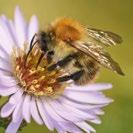

Robust and pragmatic ecological and land management surveys & advice for landowners and developments of all sizes Find out more at swtecologyservices.org
on
Chalk Grassland
to
BOOK COURSES ONLINE AT surreywildlifetrust.org/courses +Weekdays only, Excludes Cher tsey *Advanced booking essential Easter Holidays Book online Visit squiresgardencentres.co.uk Tue 2 – Fri 12 April, 9.30am – 1.30pm+ Planting ac tivit y *
Scything Upcoming Adult Learning Courses
Jean Pankhurst
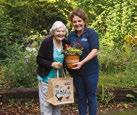
Jean Pankhurst, of West Byfleet has been an active member and supporter of the Trust for many years and thanks to her commitment, and her fundraising activities which have included collecting and selling rare stamps to raise well in excess of £10,000 for us, was made an Honorary Member in 2007.
Jean chatted to membership officer Gail Hayward about her history with us, and what still motivates her to stand up for nature.
When did you first join the Trust?
I joined way back in 1959 when it was originally called Surrey Naturalists Trust. In fact my daughter was the editior of our original magazine called ‘Nature Line’. I hugely enjoyed doing the work parties at Vann Lake, Seale Chalk Pit and Nower Wood. I used to help on the Surrey Naturalists stall and sell badges at the Surrey County Show each year, which was a great way to recruit more members and raise the profile of the Trust as it grew into a massmembership organisation.
What has been your most memorable moment?
The opening of Nower Wood in 1979. It’s such a special place, and it serves such an important role in inspiring and educating new generations of naturalists.
What do you think is the most important challenge facing Surrey’s wildlife?
Definitely loss of habitat due to new roads, new housing and an increase in population. It’s right that the Trust focuses on creating and connecting places for nature, which of course brings many benefits for people too.
How has being a member helped you protect nature in your own right?
I have always had full bird feeders in the garden, which is a great way for anyone to learn about and enjoy the natural world, and I have harvested and released new butterflies for many years.
What is your favourite Surrey habitat or species?
I have a real affection for Rabbits and Woodpeckers; the latter really benefit from places like the Nower Wood with its mix of mature deciduous trees. Although Rabbits are technically non-native, they’ve been here for 900 years!
Do you have any advice to other members or supporters of the Trust?
Be willing to volunteer for anything needed to save our wildlife for future generations. The Trust always welcomes new volunteers of any age, and it’s a great way to feel you are doing something positive and making a difference
If there are any keen philatelists out there, who could help appraise the stamps kindly donated over the years, please do get in touch!

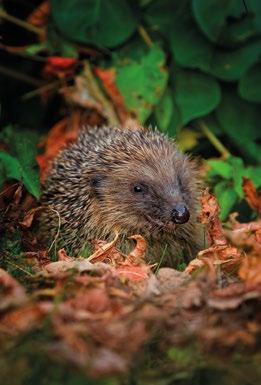

Wildlife Adoptions What’s in the pack? A cute cuddly Adoption certificate Fact booklet Photograph Adoption sticker Give the gift of nature surreywildlifetrust.org/adopt £253 species available YOUR SWT
29 SPRING MEMBER FOCUS
Great Spotted Woodpecker © TJELLIS
UK NEWS

Af ter almost completely tuna made a comeback in 2023
An historic year for marine conservation
he creation of the first Highly Protected Marine Areas in English water made 2023 an historic year for marine conservation. is huge milestone was achieved thanks to years of campaigning by e Wildlife Trusts’ sea-loving supporters e new gold-standard of protection will stop all damaging activities such as trawling and will help marine life storing habitats at sea. ese special places cover less than half a percent of English seas though, so it’s just
Marine areas weren’t the only reason to celebrate last year, with e Wildlife Trusts’ Marine Review 2023 also showing an exciting rise in sightings of apex predators – those at the very top of the food chain – in our seas. One species that created an incredible spectacle o the UK coast this year witnessed a bluefin tuna feeding event in UK waters. He said: “ e first indicator that something exciting was about to happen was seeing lots of seabirds – mainly gannets and shearwaters –gathering. As they have an aerial view, seabirds can mammals may be below the surface. As the tuna feed, the surface appears like boiling water as these
powerful and agile fish speed through the sea.” Atlantic bluefish tuna were once common in UK waters, but overfishing caused numbers to plummet during the 20th century, with the fish all but vanishing from our waters by the 1990s.
Humpback and fin whales, which were once more common around our coasts, also showed promising signs of recovery in 2023. Humpback whales were seen o Burhou, a small island northwest of Alderney (part of the Channel Islands) and o Cornwall. ere were also increased sightings of Northern fin whales, the second largest mammal in the world. Meanwhile it was a bumper year for Risso’s dolphins, with 156 sightings in 2023, compared to 45 in 2022! Reports of ‘super-pod’ feeding frenzies were reported, with common dolphins and fin whales joining in.
It wasn’t all good news however, as in contrast to these wins, the global pandemic of avian flu has sadly continued to devastate UK seabirds. While there are signs that some birds are showing immunity, vast numbers have been lost.
Discover more about our 2023 marine review here wildlifetrusts org/news/marine-review
2 Magazi ne Na me | Spr i n g 2 0 2 4
UK UPDATE B L UEFI N TUN A © R A Y HARR I N G T O N , UNS PL AS H C O M
Surrey Nature | Spring 2024 30
Vanishing rules leave farm wildlife at risk
Basic rules that help protect hedgerows and rivers on or surrounding farmland expired on 31st December 2023, with wildlife in our countryside at greater risk of harm.
ese rules, known as ‘ cross compliance’ had to be followed by farmers if they wanted to receive rural farm payments from UK Government between 2005 and 2023 To qualify, farmers were
rivers, so as to help prevent soil and farm pollution from being washed into the water ere were also rules about when hedgerows could be cut so that breeding farmland birds were protected at the most important times of year
Following the UK’s exit from the European Union, the UK Government announced that this rule would cease to exist at the end of 2023, but that it would be replaced by new UK rules.
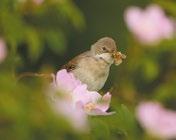
However, no new rules are in place, and the Government’s Department for Environment, Food and Rural A airs (Defra) has not confirmed whether these protections for nature will be maintained. Meanwhile, nature on farms is in limbo, with nesting birds in danger and our already struggling rivers and streams at risk of increased pollution.
e Wildlife Trusts have joined forces with National Trust and RSPB to urge the UK Government to uphold protections for nature while providing
would like to see farmers paid to take a ‘whole farm’ approach to nature -
payment schemes and access to quality independent advice on the best actions that can be taken on their farms.
Find out more at wtru st/hedgerows

With a general election expected in 2024, The Wildlife Trusts have been investigating how much nature matters to our supporters and the general public, and whether the nature policies set out by political par ties
We carried out two nationwide sur veys, which revealed that environmental charities are suppor ted by a large and politically diverse range of people – with voters feeling similarly connected to nature, regardless of where they identify on the left to right wing spectrum.
Results from Wildlife Trust suppor ters indicated that 61% would vote based on environmental policies and a fur ther 32% are considering doing the same. O f all those sur veyed (including nonsuppor ters), only 7% didn’t believe that nature loss or climate change were a serious threat to humanity.
The upcoming general elec tion will be vital for our natural world, and these results suggest that voters are calling on all political par ties to make bold plans to restore nature, tack le water pollution and halt climate change
UK H I GHL I GH T S
Discover how
The Wildlife Trusts are helping wildlife across the UK

Squirrelling away
The Great Scottish Squirrel Sur vey had more par ticipants than previous years, with just under 2,000 red and grey squirrel sightings across the countr y Ever y record helps Scottish Wildlife Trust to understand population distributions and take targeted action to protect red squirrels Sightings of both species can be repor ted all year-round. wtru.st/squirrel-sightings
Very vole done
Nottinghamshire Wildlife Trust is set to bring UK’s fastest declining mammal, water voles, back from the brink Half a million pounds from Natural England’s Species Recover y Programme will create vital wetland habitat and restore 50km of rivers to increase water vole numbers wtru.st/notts-water-vole

High security
One of our most bizarre and beautiful rare birds, the curlew, is to get £230k wor th of home improvements at Berkshire, Buck inghamshire & Oxfordshire Wildlife Trust (BBOW T ) Gallows Bridge Farm nature reser ve New pools, security cameras and anti-predator fencing will help to create new bespoke habitat for this endangered species wtru.st/curlew-habitat
Magazi ne Na me | Spr i n g 2 0 2 4 3 UK NEWS UK UPDATE
CUR L E W © T ER R Y WH I T T AKE R / 202 0 V I S I O N . POL L IN G S T A T IO N © D AN I E L HE I GH T O N SHU T TERS T OC K . WHIT E TH R O A T © ANDR E W P ARKINSO N / 202 0 VISIO N Surrey Nature | Spring 2024 31

Ali Morse, water policy manager at The Wildlife Trusts, warns of a return to the dirty history of UK waterways
Surrey Nature | Spring 2024 32
The River Wye is suffering from algal blooms due to high levels of agricultural pollution


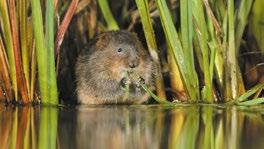
The history of UK rivers has seen raw sewage, waste chemicals and heavy metals poured into watercourses day in, day out. Great rivers like the Mersey were practically devoid of life, and as recently as the 1950’s the River Thames was considered ‘biologically dead’. Today our rivers don’t (usually) resemble putrid open sewers lined with dead fish. Yet many problems remain – poor water quality poses a threat to nature, human health and our economy.
Sewage spills
Headlines have exposed sewage spills, but the harm caused to wildlife is little understood. The UK Government’s Environment Act 2021 now requires water companies to monitor impacts and to prevent the most harmful spills. But even when wastewater is treated, the effluent from sewage treatment works may contain industrial chemicals, pharmaceuticals, household cleaning products, illicit drugs and microplastics. It’s also high in polluting nutrients like phosphorus, which fuel algal blooms, depleting oxygen and harming aquatic plants, insects, fish and other species.

Thanks to campaigning by supporters of The Wildlife Trusts and others, the UK Government was recently blocked from weakening water protections in places where nutrients are already harming sensitive rivers and coasts. These rules are known as nutrient neutrality and require developers to offset additional pollution from sewage from new housing. They help to prevent development from harming our most important wildlife sites.
Farming failures
Farming is the sector responsible for the greatest number of waters failing ecological standards. Excess fertiliser, manure, slurry and eroding soil can all deliver harmful doses of nitrogen or phosphorus to our rivers. Pesticides and veterinary medicines add into the mix. This toxic cocktail of chemicals also flows downstream, contaminating our seas.
Grants can help farmers to provide sufficient storage capacity for slurry and to manage rainwater from yards and roofs that contributes to runoff. Essential environmental schemes encourage farmers to plant cover crops and riverside ‘buffers’ to prevent soil erosion.
Despite these efforts, collectively these pressures mean our waters are under huge strain. Across the UK, only 36% meet ecological standards and are in good enough condition for wildlife. In England, where pressures are greatest, the figure is just 16%. Phosphorus pollution is the most common cause of failure, so water companies are required to upgrade numerous treatment works by 2030 to strip out phosphate, and more action will be needed from farming too.
Working with nature
From Dorset to Durham, Wildlife Trusts are finding novel ways to prevent nutrient pollution reaching our waters and creating habitat where nature can thrive. In Wiltshire, a chalk stream with habitat for spawning brown trout and endangered water vole is being protected by a restored wetland where road runoff and nutrient-loaded sediment is now captured from fields before it reaches the River Avon.
In Scotland, Warwickshire, Shropshire and Herefordshire, Wildlife Trusts are creating wetland features in farmland, river valleys and towns that capture water in the landscape, reducing flood risk downstream and stopping sewers from being overwhelmed. In other areas, beavers are doing this work for us. Termed ‘nature-based solutions’, these approaches see nature playing a central role in helping to tackle pollution, whilst also creating spaces where eels, kingfishers, otters and other aquatic life can thrive.
The old adage ‘the solution to pollution is dilution’ only works up to a point. Instead, the priority must be prevention of pollution at source – all UK governments, farmers, water companies and even the public all have a role to play. But then, when we’ve exhausted all efforts but still have pollution to tackle in our river systems, we know that nature can help.
Ask your local MP what they intend to do about river pollution and whether policies to protect clean rivers are part of their election manifesto. To find out more about our general election priorities visit wildlifetrusts.org/end-river-pollution
ALGAL BLOOM ON THE RIVER WYE
© WILL WATSON, NATUREPL.COM; SEWAGE POLLUTION © SHUTTERSTOCK; WATER VOLE © TERRY WHITTAKER/2020VISION
Ali Morse is water policy manager at The Wildlife Trusts. She works collaboratively across the movement, with all Wildlife Trusts and with other organisations, to call for better protections for the water environment.
Sewage spills are harming wildlife and wild places
Surrey Nature | Spring 2024 33
Water voles are one of the species at risk of habitat loss
migrating birds 6 places to see

CUCKOO © LUKE MASSEY/2020VISION Surrey Nature | Spring 2024 34
pring is a time of great change in the wild world. As the days grow brighter and warmer, millions of birds are on the move. They leave their winter refuges and race back to their breeding grounds, driven by the urge to find a mate and raise some chicks.
Cuckoos, ospreys, warblers and many more birds are returning to the UK from the warmer regions of southern Europe or Africa. They don’t all arrive at once; each species has its own schedule. Sand martins and wheatears begin arriving in March, but quails and nightjars are stragglers, appearing as late as May.
On some spring days, you can see migration in action, with flocks of birds flying overhead on their way to their summer home. Birdwatchers call this visible migration, or vismig for short. But flying is hard work, so keep an eye out for migrants stopping off to spend a few hours refueling before continuing their journey.
Here are six of our best nature reserves for experiencing spring migration.

See the spectacle for yourself

1 Cemlyn Nature Reserve, North Wales Wildlife Trust
An incredible site to visit on the wild coast of Anglesey, with its unique, shingle ridge. Cemlyn welcomes a wide range of wading birds and between May and July is host to nesting colonies of Sandwich, common and Arctic terns.
Where: Anglesey, LL67 0EA
2 Red Rocks Nature Reserve, Cheshire Wildlife Trust
On the edge of the Dee Estuary, this nature reserve is an excellent coastal spot for birdwatching with sand dunes, reed beds and marsh attracting regular spring migrants like reed buntings, sand martins and wheatears.
Where: Hoylake, CH47 1HN
3 Spurn National Nature Reserve, Yorkshire Wildlife Trust
One of the best sites in the UK for visible migration, with thousands of birds passing overhead. The adjacent Humber Estuary is of international importance for its vast numbers of wildfowl and wading birds passing through.
Where: Hull, HU12 0UH
4 Christopher Cadbury Wetland Reserve, Worcestershire Wildlife Trust
Worcestershire’s premier bird-watching nature reserve, Upton Warren attracts birds throughout the year. It is home to the UK’s first inland breeding avocets and attracts lots of wading birds while on passage as a vital stop over.
Where: Wychbold, B61 7ER
5 Walthamstow Wetlands, London Wildlife Trust
An internationally important site for migrating birds, Walthamstow Wetlands is excellent for an urban vismig. Just 15 minutes from central London, you will find a unique city oasis to connect with the magical world of migrating birds.
Where: Walthamstow, N17 9NH
6 Rye Harbour Nature Reserve, Sussex Wildlife Trust
In spring, gull numbers increase, and oystercatcher and dunlin feed along the shore and roost on the shingle at high tide. Gannets and flocks of Brent geese also return on their eastward passage to breeding grounds.
Where: Rye, TN31 7FW
Did you spot any migrators?
We’d love to know how your search went.
Please tweet us your best photos! @wildlifetrusts
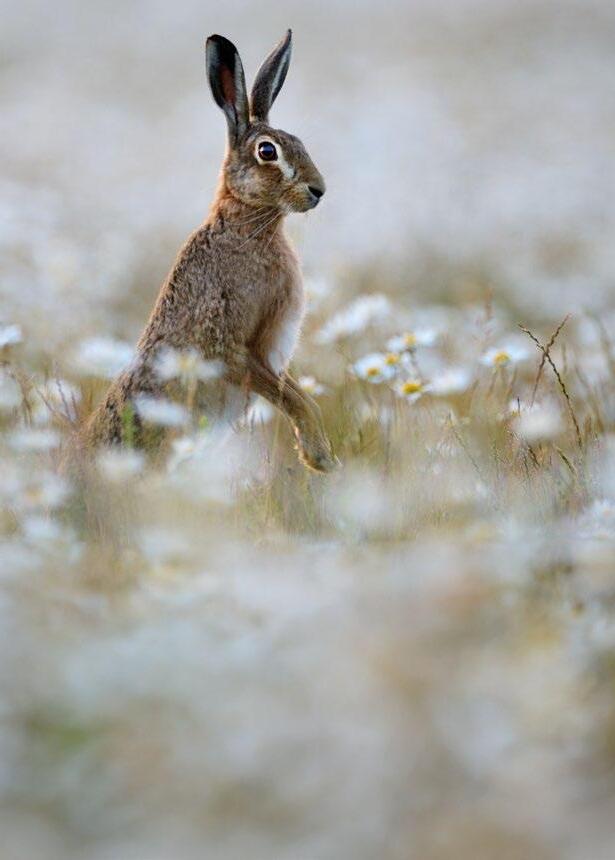
Make a difference for local wildlife with a gift in your Will From safeguarding precious grasslands to creating new homes for wildlife across Surrey, just a 1% gift in your Will can help us protect nature and inspire future generations We’d love to hear from you, so if you’d like to discuss leaving a gift in your Will or to find out more information, please contact us on 01483 795 445, or by emailing jennifer.mason@surreywt.org.uk surreywildlifetrust.org/legacies Registered Charity No. 208123 Surrey Wildlife Trust is a company limited by guarantee, registered in England no. 00645176. Registered office School Lane, Pirbright, Surrey, GU24 0JN David Tipling/2020VISION Scan for more info




 Sarah Jane Chimbwandira Chief Executive
© Jon Hawkins
Sarah Jane Chimbwandira Chief Executive
© Jon Hawkins
























 Jo
Students at Powell Corderoy School, Dorking using aerial photography and survey skills to map habitats and create their visions for nature.
Jo
Students at Powell Corderoy School, Dorking using aerial photography and survey skills to map habitats and create their visions for nature.










 © Andy Morffew
Suburban Bohemians: supermarket car parks are an important source of berries © Terry Whittaker / 2020VISION
Redwings love Holly berries
© Jon Hawkins
Waxwing
© Jon Hawkins
The unmistakeable but elusive Hawfinch
© Andy Morffew
Suburban Bohemians: supermarket car parks are an important source of berries © Terry Whittaker / 2020VISION
Redwings love Holly berries
© Jon Hawkins
Waxwing
© Jon Hawkins
The unmistakeable but elusive Hawfinch












































